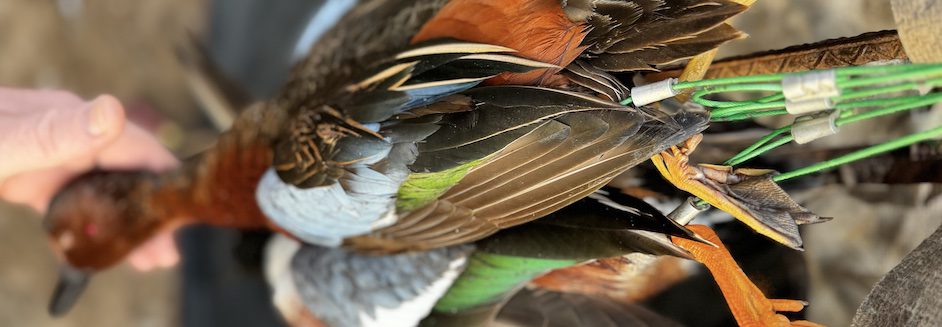Cinnamon Teal
Cinnamon Teal (Spatula cyanoptera, previously classified as Anas cyanoptera) are striking waterfowl, akin to their blue-winged teal and shoveler counterparts. They boast distinctive light blue wing patches and dark green speculums, elegantly accented by a white stripe formed by secondary coverts. Their yellow legs and graphite-colored bills add to their allure. During the wintering months, drake cinnamon teal undergo a stunning transformation, donning a showy, ruddy, dark-paprika colored plumage that envelops their head, breast, and underbelly. Additionally, they sport black coloring running down their back, covering the tail, creating a captivating sight. The contrast of nutmeg-colored tertials against the cinnamon body plumage is particularly striking.
In their non-breeding season, drakes adopt a mottled brown coloration akin to hens, with their wing feathers taking on a deep brown hue, fringed with a lighter brown. Distinguishing cinnamon teal from blue-winged teal becomes easier during this time, as cinnamon teal exhibit wider and longer black bills, accompanied by the drake’s bright red eyes. Globally, up to five races of cinnamon teal are recognized, each with its own unique characteristics and distribution.

Cinnamon teal are known to breed in two distinct regions: North America and South America, with minimal intermingling between populations from these regions. In North America, breeding populations are absent in mid-inland states, instead favoring the western coast of the United States, extending as far inland as western Texas and reaching into Canada. They exhibit a preference for marshy habitats rich in vegetation, providing both cover and foraging opportunities. These wetland areas, characterized by mucky bottoms, cattails, and sedges, serve as vital breeding grounds for cinnamon teal.
Throughout the year, cinnamon teal rely on shallow freshwater marshes, emphasizing their preference for specific habitat conditions. During migration, they predominantly overwinter in western Mexico, although some individuals may linger in California, Arizona, New Mexico, and Texas. Unlike green-winged and blue-winged teal, cinnamon teal tend to travel in small family cohorts, primarily feeding on vegetation, snails, and other invertebrates. It’s rare to encounter sizable flocks of cinnamon teal, except in certain regions such as Peru.
Cinnamon teal, with its vibrant plumage and distinct habitat preferences, stands out as a captivating species among waterfowl enthusiasts and birdwatchers alike. Understanding its unique characteristics and ecological requirements is crucial for conservation efforts aimed at preserving its populations and ensuring their continued presence in wetland ecosystems across the Americas.
Available Hunts
-
Argentina Duck Hunt – Parana River Delta
An Argentina duck hunt destined to become absolute legend, the Parana River Argentina duck hunting an immersive adventure in one of the wildest places ever.
...read more- Wildest, most remote duck hunt in Argentina, pure adventure
- Luxury liveaboard accommodations, < 15 minutes from duck blind
- Amazing gourmet meals, excellent wine selection (an Argentina wine tasting offered each week)
- Located about 4-5 hours travel from downtown BA, last 1.5 hours by boat
- Rosy-billed pochards, white-cheeked pintails and teal predominate the bag
- Choose high-volume ducks twice daily, or afternoon golden dorado fishing
Rate: $975 -
Argentina Duck Hunting Las Flores
High-volume Argentina duck hunting is a "real duck hunter's duck hunt" that consistently produces over-the-top action. You've tried the rest, now come try the very best!
...read moreArgentina duck hunting Las Flores is our poster-boy Argentina duck hunt. For over a decade, this operator consistently delivers generous duck limits without fail. Convenient hunt that all duck hunters will enjoy.
- Fun, fast-paced duck hunts, generous limits every single day without excuses
- Tons decoying rosy-bills, all Argentina species available
- Located 5.5 hours from EZE, < 30 minutes to blinds
- Great lodging, superior meals, best-stocked bar in Argentina
- As featured MOJO TV; Wildfowl, Predator Nation, Peterson’s and Trigger, Field & Stream, more
Rate: $1,150 -
Argentina Duck Hunting Rio Salado
High-volume Argentina duck hunting a remote wetland that's well worth the effort.
...read moreArgentina duck hunting Rio Salado for die-hard duck hunters that will go the distance for high-volume shooting, high species diversity, and unspoiled habitat. Welcome to real Argentina.
- NO LONGER BOOKING THIS HUNT!
- Remote 74,000-acre wetland
- 1 hunter per blind unless requested
- Pure duck hunting
- Bilingual hosting for the entire trip
- Featured MOJO TV, Outdoor Life, Wildfowl, Sports Afield
Rate: N/A -
Mexico Duck Hunting Mazatlan
Mexico duck hunting Mazatlan ("honeymoon duck hunt") is the South-of-the-border duck hunting experience that surpasses all others.
...read moreMexico Duck Hunting Mazatlan is the easiest duck hunt you’ll ever get your wife onboard with because she’ll have just as much fun. Win-win duck hunting vacation as ever existed.
- Honeymoon duck hunting, non-hunting spouses enjoy it as much as hunters!
- January through mid-March (Valentine’s Day always sells-out first!)
- Resort hotel lodging, guaranteed great views (choose your own reservations and amenity levels while booking directly)
- Over 15 trophy duck species including Cinnamon Teal
- Generous 25-duck daily bag limits
- Many fun non-hunting activities
Rate: from $3,850 -
Mexico Duck Hunting Nayarit
I invite you to experience authentic Mexico duck and dove hunting at its very best. INCLUSIVE Mexico Duck Hunting Nayarit Combo is genuine yesteryear Mexico duck hunting
...read moreAvailable only through GetDucks.com, the Nayarit Mexico duck hunt combo package represents superior bang-for-the-buck value and is truly inclusive, including everything but flying into to Mazatlan and the ammo you shoot.
- Includes everything but flying into Mazatlan and your ammo. That’s it!
- Morning ducks, afternoon doves, 6 hunts, generous limits
- Prized species include blue-winged teal, cinnamon teal, green-winged teal, northern shovelers, black-bellied whistlers, fulvous whistlers, more.
- Minimum 4 hunters, maximum 6, exclusive groups only.
- Best, most authentic meals in Mexico.
- Minimum 4 hunters
Rate: $4,240 INCLUSIVE -
Mexico Duck Hunting Obregon
Mexico duck hunt combo for real duck hunters. All-day hunts for broad variety of Central Flyway and Pacific Flyway duck species.
...read moreMexico duck hunting combo in Obregon is an action-packed “real duck hunters duck hunt” for ducks, doves, options for trophy bass fishing and quail.
- Trophy duck species for nearly all Central and Pacific flyway species to include cinnamon teal, Mexican mallard, more!
- Generous bag limits
- Elegant and Gambel’s quail, trophy largemouth bass fishing options
- Premium, 9-bedroom estancia and unequalled guest services
- Featured – Wildfowl, World of Beretta, MOJO TV, Outdoor Life, NRA Hunter, more
Rate: $4,880 (4-day hunt) -
Mexico Duck Hunting Sonora
Mexico Duck Hunt package is intended for private groups of 4-7 hunters.
...read moreMexico Duck Hunting Sonora Combo was developed at the request of many repeat clients who wanted to enjoy morning Mexican duck hunting, afternoon dove hunts, with their own exclusive groups.
- 4-night, 3-day packages, January-February
- For private groups of 4-6 hunters
- Morning duck hunts, afternoon dove hunts
- Premium, 4-bedroom estancia, all bedrooms with ensuite facilities
- Excellent waterfowl species selection
Rate: $4,080 (3-day hunts) -
Peru Duck Hunting
Peru duck hunting trip for greatest concentration of Cinnamon Teal in the world
...read more- Highest density of cinnamon teal in the world
- Liberal limits, moderately easy walk in hunts, waders or hip boots suggested
- Hotel accommodations, restaurant meals of regional specialties
- Expert guide services and translation
- Combine with Mountain species
- Season May 1 – Nov 30
Rate: $850 -
Texas Waterfowl Hunt – Desert Paradise
Texas waterfowl hunt packages features relatively unpressured ducks, geese and sandhill cranes in an area so large it takes 3 lodges to cover and so ecologically diverse that most Central Flyway waterfowl species can be hunted!
...read more- Inclusive Texas waterfowl hunting packages for ducks, geese, sandhill cranes, doves, early blue-winged teal, spring turkeys, more.
- 3 lodges to cover vast, relatively undisturbed waterfowl hunting area and to offer flexibility for desired bucket-list species, amenity-level needs, or personal budget
- Central flyway puddle ducks to include prized mottled duck, Mexican duck, cinnamon teal, fulvous whistling duck, black-bellied whistling duck opportunities all right here in USA
- Sandhill crane hunting and white-fronted goose hunting are the Speck Ops Waterfowl house specialties
- Luxurious lodging with over-the-top and fun activities provide fun for bachelor or business hunting groups, entire families and non-hunters,
Rate: $2,000 to $2,900
As many as 5 races of cinnamon teal are recognized worldwide. There are two separate regions for breeding, one in North America and one in South America, these two groups will not mix. Breeding populations in North America do not occur at all in the mid-inland states, but rather breed along the western coast of the United States (furthest inland is western Texas) and a little up into Canada. Cinnamon teal like rank marsh, prefering wetland areas with vegetation that can be used for cover as well as for foraging, some of which include. Think mucky-bottoms, cattails, sedges. Requirements for shallow freshwater marsh conditions are preferred year-round. Cinnamon teal migrate overwinter nearly exclusively in western Mexico, with a few holdovers in California, Arizona, New Mexico, and Texas.
Cinnamon teal travel in small family cohorts to feed on vegetation, snails and other invertebrates. With the exception of Peru, rarely are they encountered in sizable flocks as such seen in green-winged and blue-winged teal, especially on wintering grounds.

Spatula cyanoptera genus is derived from its mandible. Characterized by their large, spoon-shaped bills, which they use to filter food from the water’s surface. This genus encompasses several species of dabbling ducks, notably the Northern Shoveler (Spatula clypeata) and Blue-winged Teal (Spatula discors) in North America. Members of the Spatula genus number 8 worldwide and are widely distributed across various continents and are often found in freshwater habitats such as marshes, lakes, and rivers. With their vibrant plumage and unique feeding behavior, these ducks play an essential role in maintaining the ecological balance of their respective ecosystems.








